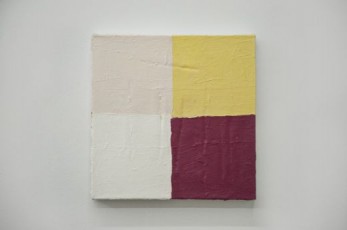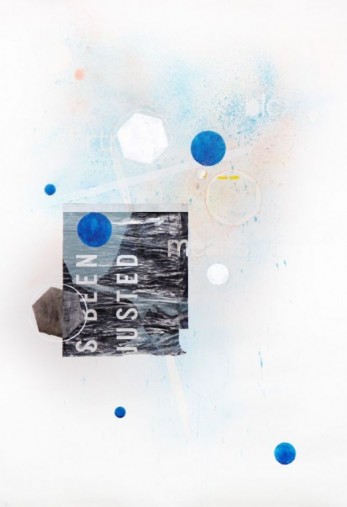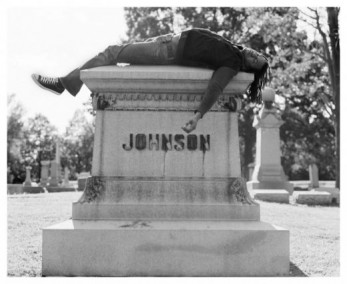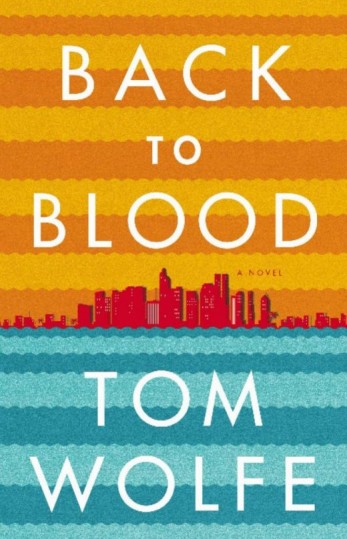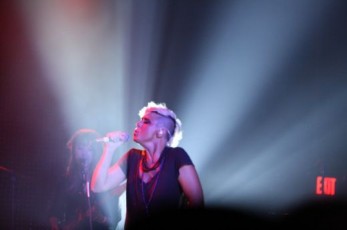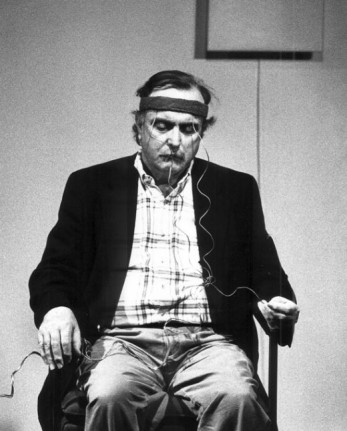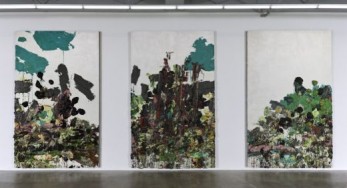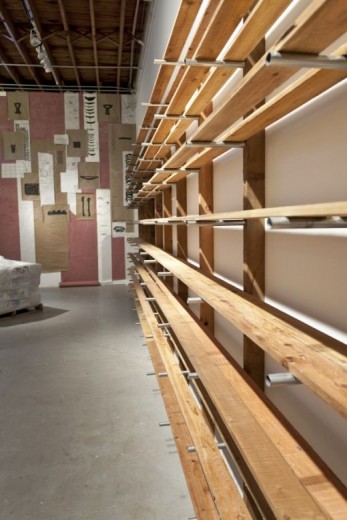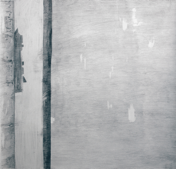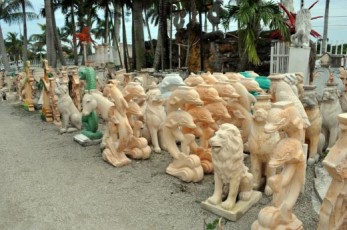This illusion in the paintings is the work, and through this illusion she performs an exit to the game. The basis for this is a very sensitive, refined and assertive gesture.In a simultaneously natural and forced manner, she covers the entire canvas with textural brush marks that look more like the residue of a glue stick than paint.
Interested in sculptural problem solving, function, and fabrication, Moore reduces tables, hanging lights, and wall tiles to smart and basic forms. Computer rendering programs can allow for a certain level of fantasy: you can skew the perspective, apply surface treatments, select and perfect, just by sending commands.
Invested in what we might call vernacularism, Adler Guerrier’s most recent solo exhibition, Here, Place the Lever at David Castillo Gallery, is a semiotic investigation and poetic rendering of the urban landscape of Miami.
A central feature of many of his recent works, Johnson’s use of mirrors functions on multiple levels: reflecting the viewer, reflecting other works across the gallery, and offering windows of space inside which viewers can participate in alternate, duplicate, and distorted realities.
I first met Tom Wolfe at a table I had booked for lunch in London’s West End. I hadn’t known about the white suit, but there it was, already trademarked, the shoulders filled out then, and the tie a closer match to those electric blue eyes. I don’t remember what we talked about (who used a tape recorder in the Sixties?), just that I was in the presence of a reverse Hemingway paradigm, on literary ground that, if not exactly cracked open, as with Anthony Burgess’s A Clockwork Orange, had at least shifted tectonically. Wolfe’s new journalism pioneered sentences that flung punctuation in the air, printing the dashes and ellipses where they landed and piling electric verbs on kandy-kolored adjectives to catch the zeitgeist of a generation that had moved from baseball and crinolines to racing cars and rags.
The pleasure of cratered statues. Flowers of fractured cubes and mannequin bouquets. Creams, Latin grammar manuals and the seams of torn fabrics. Yarn from childish dolls and little brittle hairs. An aisle lost in aisles of aisles and aisles alone. Rafters, ice-skating bandages and shattered ceiling candles. Taboo of wax grapes and petit-bourgeois artichoke convolutions. Panels of copper-piping virgins. Post-it-notes and sprained-ankle pamphlets. The coverlet of your pillow. Unfathomed wheels and hearty transcriptions of Public Discourse. Pearl-eyed banisters and sandwiches wrought in iron. Letter-press monographs on widgets, inflated mistresses and elbow assembly lines.
Andy came in to work on his sculpture. Andy’s hair is nonstop bright orange and the orange bursts in every direction. He said I looked sick and I told him I’m not so bad but I could not really move from where I am still laying now. He chipped away at the clump of 2×4’s he’s glued together and now that chipped clump is painted bright orange and is drying. Now I am sweating and I cannot move and everything hurts.
Cat Power emerged from the Grand Central Miami green room around 10 p.m. on the evening of October 11 sporting a bleached-blonde mohawk, balancing a lit candle in one hand and a plastic cup half-full of an unidentifiable, clear liquid in the other, and looking particularly distressed. (Little did I know, she had been hospitalized for unspecified reasons at Miami Beach’s Mt. Sinai Medical Center just a couple of weeks earlier).
“I am sitting in a room different from the one you are in now. I am recording the sound of my speaking voice and I am going to play it
back into the room again and again until the resonant frequencies of the room reinforce themselves so that any semblance of my
speech, with perhaps the exception of rhythm, is destroyed. What you will hear, then, are the natural resonant frequencies of the
room articulated by speech. I regard this activity not so much as a demonstration of a physical fact, but more as a way to smooth out
any irregularities my speech might have.”
You smell the paintings in the back of your throat and try to take shallow breaths. The three 16-foot-tall oils strive upwards to the ideal of unsullied negative space. On average, the paintings weigh half a ton. The canvas at the top of the frames is stretched gale-taught. At the bottom, the weight of the paint has distended the surface to a slack edema. And while the triptych has the undeniable outline of a 山 (shan), the simplified character for mountain, the artist insists that it be displayed 3-2-1, with the peak still centered and the slopes switched. This choice, coupled with a palate of broad swathes of green littered with more muted industrial hues, evokes the cities surrounding the Yangtze that were abandoned and submerged during the earth-moving Three Gorges Dam project.
Chicago-based artist Theaster Gates opened his first solo exhibition in Miami at Locust Projects this November. Soul Manufacturing Corporation transforms the gallery space into a site for the actual production of goods, making the labor of the artists who will work in the space available for public consumption. This project is the outgrowth of a practice that encompasses sculpture, painting, performance, singing, ceramics, and installation, alongside urban planning, construction, and community engagement. In anticipation, Gates and Diana Nawi, Associate Curator at the Miami Art Museum, exchanged emails and phone calls in late October of this year.
While he and she consciously adhered to constructed systems of thought and representation, inevitably others emerged, making themselves self-evident within the texts and their structures. As she often points out, “This emergence is comparable to the regular process that underlies those dry conversations who goals become apparent over the course of what appears to be an idle exchange.”
But there were also a series of contingent factors. At the beginning, there was an apartment, a really shitty apartment, inside the space. There was no money for car rentals, so basically when artists came to work they were inside our lives. If there was a party we were going to, that’s where they were going. They just became grafted into your world and to the local scene. And so if you were going to play poker at someone’s house, he or she was going to go play poker, too. That was not a formal-artworld-dinner-with-a-board-member kind of thing.
I walked twenty blocks from Wynwood to Downtown Miami before I took a car back along the same route an hour later. At a foot pace, the garages and open lots showed me their garbage, their tired weeds, their trucks parked at extravagant angles. The limp X where the train tracks meet North Miami Avenue was a real no-man’s land: left without a curb or a zebra, I scurried across to the safety of the shady sidewalk beside the cemetery. On the return drive, the street-level entropies receded from my sped-up gaze, which took in the horizons of high-rises, the persuasive lines of the city in its totality.
Shanghai has, in the past few decades, transformed from a vast, grubby warehouse of poverty into one of the premier spaces for finance capital, with the accompanying luxury apartments, nightclubs, gyms, and lifestyle paraphernalia that that entails; the neighborhood in which the biennale is held hasn’t yet been hit by this wave, and it is unclear whether the “Reactivation” theme is intended to bring back the ghosts of the past, or clear them away more quickly.
South Floridians already know what recent census data tells us: increasingly, urban living is actually suburban living. Today’s American cities continue to spread well beyond their traditional urban cores, transforming former farm fields, forests, and wetlands in the process. In South Florida, the suburbs connect and subvert the boundaries of once distinct cities. They are patchy landscapes where residential developments, strip malls, and autorepair shops intermingle. The suburbs are also the place most of us call home. Perhaps it is this very intimacy we have with the suburbs that accounts for the widespread anxieties they seem to produce.

